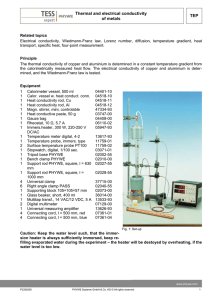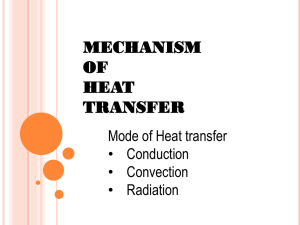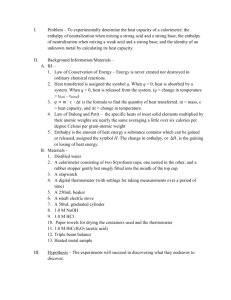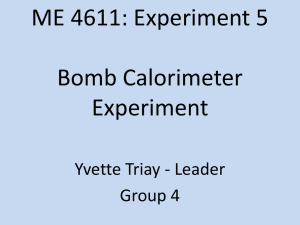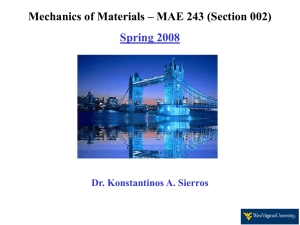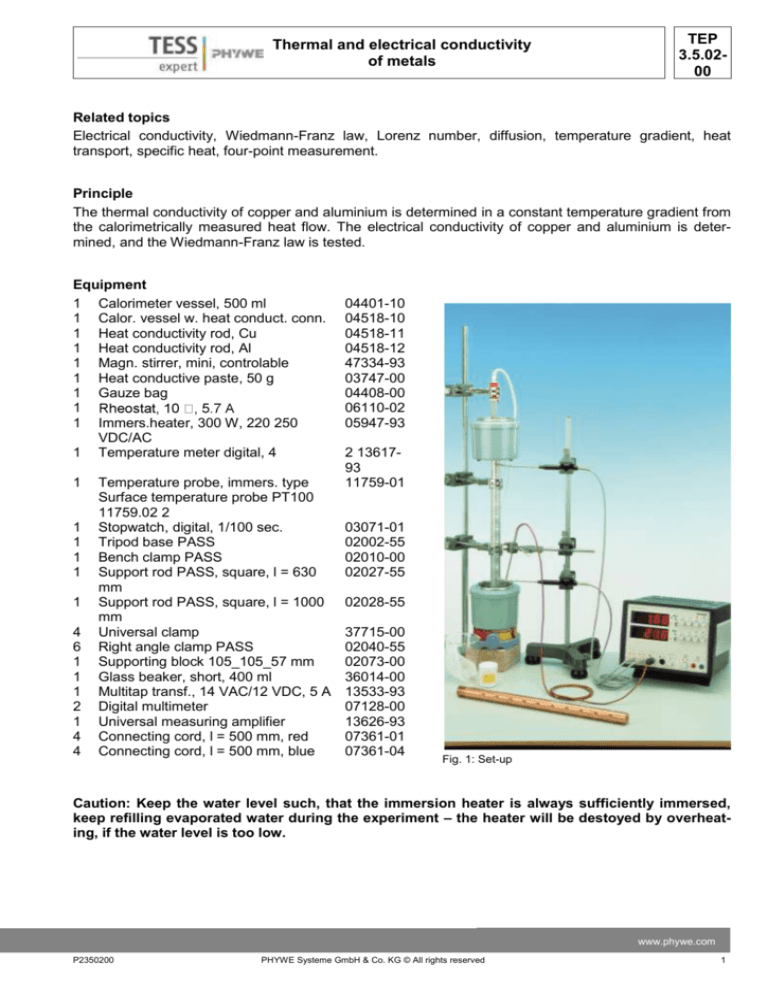
Thermal and electrical conductivity
of metals
TEP
3.5.0200
Related topics
Electrical conductivity, Wiedmann-Franz law, Lorenz number, diffusion, temperature gradient, heat
transport, specific heat, four-point measurement.
Principle
The thermal conductivity of copper and aluminium is determined in a constant temperature gradient from
the calorimetrically measured heat flow. The electrical conductivity of copper and aluminium is determined, and the Wiedmann-Franz law is tested.
Equipment
1 Calorimeter vessel, 500 ml
1 Calor. vessel w. heat conduct. conn.
1 Heat conductivity rod, Cu
1 Heat conductivity rod, Al
1 Magn. stirrer, mini, controlable
1 Heat conductive paste, 50 g
1 Gauze bag
1
1 Immers.heater, 300 W, 220 250
VDC/AC
1 Temperature meter digital, 4
1
1
1
1
1
1
4
6
1
1
1
2
1
4
4
Temperature probe, immers. type
Surface temperature probe PT100
11759.02 2
Stopwatch, digital, 1/100 sec.
Tripod base PASS
Bench clamp PASS
Support rod PASS, square, l = 630
mm
Support rod PASS, square, l = 1000
mm
Universal clamp
Right angle clamp PASS
Supporting block 105_105_57 mm
Glass beaker, short, 400 ml
Multitap transf., 14 VAC/12 VDC, 5 A
Digital multimeter
Universal measuring amplifier
Connecting cord, l = 500 mm, red
Connecting cord, l = 500 mm, blue
04401-10
04518-10
04518-11
04518-12
47334-93
03747-00
04408-00
06110-02
05947-93
2 1361793
11759-01
03071-01
02002-55
02010-00
02027-55
02028-55
37715-00
02040-55
02073-00
36014-00
13533-93
07128-00
13626-93
07361-01
07361-04
Fig. 1: Set-up
Caution: Keep the water level such, that the immersion heater is always sufficiently immersed,
keep refilling evaporated water during the experiment – the heater will be destoyed by overheating, if the water level is too low.
www.phywe.com
P2350200
PHYWE Systeme GmbH & Co. KG © All rights reserved
1
TEP
3.5.0200
Thermal and electrical conductivity
of metals
Tasks
1. Determine the heat capacity of the calorimeter in a mixture experiment as a preliminary test. Measure
the calefaction of water at a temperature of 0°C in a calorimeter due to the action of the ambient temperature as a function of time.
2. To begin with, establish a constant temperature gradient in a metal rod with the use of two heat reservoirs (boiling water and ice water) After removing the pieces of ice, measure the calefaction of the cold
water as a function of time and determine the thermal conductivity of the metal rod.
3. Determine the electrical conductivity of copper and aluminium by recording a current-voltage characteristic line.
4. Test of the Wiedemann-Franz law.
Set-up and procedure
1. Measurement of the heat capacity of the lower calorimeter
Weigh the calorimeter at room temperature.
Measure and record the room temperature and the temperature of the preheated water provided.
After filling the calorimeter with hot water, determine the mixing temperature in the calorimeter.
Reweigh the calorimeter to determine the mass of the water that it contains.
Calculate the heat capacity of the calorimeter.
Determine the influence of the heat of the surroundings on the calefaction of the water (0 °C without
pieces of ice) by measuring the temperature change in a 30-minute period.
2. Determination of the thermal conductivity
Perform the experimental set-up according to Fig. 1.
Weigh the empty, lower calorimeter.
Insert the insulated end of the metal rod into the upper calorimeter vessel. To improve the heat
transfer, cover the end of the metal rod with heat-conduction paste.
Attach the metal rod to the support stand in such a manner that the lower calorimeter can be withdrawn from beneath it.
The height of the lower calorimeter can be changed with the aid of the supporting block. When doing
so, care must be taken to ensure that the non-insulated end of the rod remains completely immersed in the cold water during the experiment.
The surface temperature probe must be positioned as close to the rod as possible.
The outermost indentations on the rod (separation: 31.5 cm) are used to measure the temperature
difference in the rod. To improve the heat transfer between the rod and the surface probe, use heatconduction paste.
Using an immersion heater, bring the water in the upper calorimeter to a boil, and keep it at this
temperature.
Caution: Keep the water level such, that the immersion heater is always sufficiently immersed,
keep refilling evaporated water during the experiment – the heater will be destoyed by overheating, if the water level is too low.
Ensure that the upper calorimeter is well filled to avoid a drop in temperature due to contingent refilling with water.
Keep the water in the lower calorimeter at 0°C with the help of ice (in a gauze pouch).
-
2
PHYWE Systeme GmbH & Co. KG © All rights reserved
P2350200
TEP
3.5.0200
Thermal and electrical conductivity
of metals
-
-
-
-
-
-
The measurement can be begun when a constant temperature gradient has become established between the upper and lower surface
probes, i.e. when no changes occur during the
differential measurement.
At the onset of measurement, remove the ice
from the lower calorimeter.
Measure and record the change in the differential
temperature and the temperature of the water in
the lower calorimeter for a period of 5 minutes.
Weigh the water-filled calorimeter and determine
Fig. 2.
the mass of the water. Settings of the temperature measuring device 4-2:
In the first display on the measuring device, the temperature of the lower calorimeter is displayed.
In the second display, the differential measurement between the upper and the lower surface probe
is shown.
The thermal conductivity of different metals can be determined from the measuring results.
3. Measurement of the electrical conductivity.
Perform the experimental set-up according to the circuit diagram in Fig. 2 (set-up in accordance with
a 4-conductor measuring method).
Set the voltage on the variable transformer to 6 V.
The amplifier must calibrated to 0 in a voltage-free state to avoid a collapse of the output voltage.
Select the amplifier settings as follows: Input: Low Drift Amplification: 104 Time Constant: 0
Set the rheostat to its maximum value and slowly decrease the value during the experiment.
Read and note the values for current and voltage
The resistance, and thus the electrical conductivity, can be determined from the measured
values.
Theory and evaluation
If a temperature difference exists between different
locations of a body, heat conduction occurs. In this
experiment there is a one-dimensional temperature
gradient along a rod. The quantity of heat dQ
transported with time dt is a function of the crossFig. 3. Diagram: Heat of surroundings over time.
sectional area A and the temperature gradient
_T/_x perpendicular to the surface.
The temperature distribution in a body is generally a function of location and time and is in accordance
with the Boltzmann transport equation
www.phywe.com
P2350200
PHYWE Systeme GmbH & Co. KG © All rights reserved
3
TEP
3.5.0200
Thermal and electrical conductivity
of metals
Where _ is the density and c is the specific heat capacity of the substance.
After a time, a steady state
is achieved if the two ends of the metal rod having a length l are maintained at constant temperatures T1
and T2, respectively, by two heat reservoirs.
Substituting equation (3) in equation (2), the following equation is obtained:
T (x) = · x + T1 (4)
1. The heat capacity of the calorimeter is obtained from results of the mixing experiment and the following formula:
The measurement supplies a value of approximately 78 J/K ±25%. The large variations in the results are
a result of the manner in which the experiment is performed and of the experimental set-up.
The addition of heat from the surroundings is calculated from the temperature increase (T of the cold water in the calorimeter.
4
PHYWE Systeme GmbH & Co. KG © All rights reserved
P2350200
Thermal and electrical conductivity
of metals
TEP
3.5.0200
2. The heat energy supplied to the lower calorimeter can be calculated using Equation (6). The values
and the change in the temperature difference on the metal rod are plotted as a function of time.
In the diagram illustrating the temperature difference, one can see that the temperature essentially remains constant. Consequently, equation 3 can be considered as having been satisfied. In order to calculate the heat energy transported by the metal rod according to Equation 1, the ambient heat fraction
must be subtracted.
dQ/dt for the ambient heat can be calculated from the slope of the graph in Fig. 3. dQ/dt for the entire
set-up can be calculated from the slope of the graph of Q over t in Figs. 4 and 5. With the values for the
length of the rod (∆x = 31.5 cm), the area (A = 4.91 · 10-4 m2) and the averaged temperature on the metal
rod, the heat conduction number can be calculated using Equation (1). The following result as the average values:
3. At room temperature the conduction electrons in metal have a much greater mean free
path than the phonons. For this reason heat
conduction in metal is primarily due to the electrons. The resulting correlation between the
thermal conductivity _ and the electrical conductivity _ is established by the WiedemannFranz law:
Fig. 4a: _T as function of time for aluminium.
The Lorenz number L, which can be experimentally determined
www.phywe.com
P2350200
PHYWE Systeme GmbH & Co. KG © All rights reserved
5
TEP
3.5.0200
Thermal and electrical conductivity
of metals
using Equation (8), is established by the theory of electron vapour (for temperatures above the Debye
temperature) to be:
The electrical conductivity is determined by the resistance R of the rod and its geometric dimensions (l =
0.315 m, A = 4.91 · 10-4 m2).
From Equation (8) The following values result for T =
300 K and the λ from the second part of the experiment.
R/10-6 Ω
σ/107 (Ωm)-1
L/10-8 WΩK-2
Al
19.6
3.27
2.5
Cu
12.04
5.33
2.35
Fig. 4b: Q as a function of time for aluminium.
The Debye temperatures of copper and aluminium are 335 K and 419 K, respectively. Below the Debye
temperature the ratio of the conductivity is smaller than given by Equation (8).
Fig. 5a: _T as function of time for copper.
6
Fig. 5b: Q as function of time for copper.
PHYWE Systeme GmbH & Co. KG © All rights reserved
P2350200

